After the diagnosis of their dog’s torn ACL, treatment without surgery is something that many dog parents ask their veterinarian about. To thoroughly address the topic, integrative veterinarian Dr. Julie Buzby brought in an expert—board-certified rehabilitation veterinarian Dr. Britt Carr Benson. Dr. Carr Benson provides the background information on ACL tears in dogs and then discusses seven ways to help a torn ACL heal without surgery.
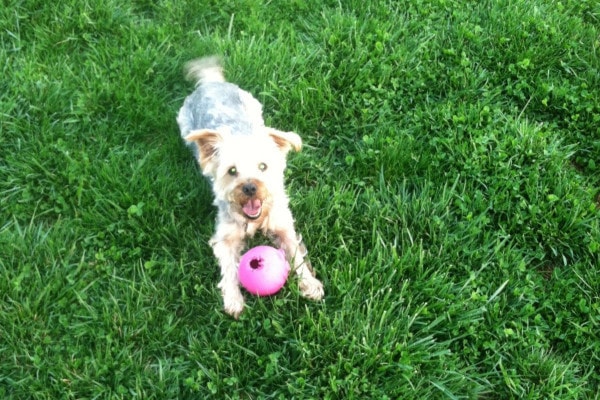
- Meet Tumbles
- What is the cranial cruciate ligament (CCL) in a dog?
- What causes CCL injuries in dogs?
- How do you treat a CCL injury in dogs?
- How does non-surgical treatment compare to surgery?
- 7 Ways to treat a dog's torn ACL without surgery
- Tumbles' success story
- Note from Dr. Buzby
- About the author
- If you decided to treat your dog's torn ACL without surgery, how did he or she do?
Meet Tumbles
One of my rehab patients, Tumbles, is a 10-year-old male neutered mixed breed dog. He was an avid ball-chaser and swimmer before coming up lame in his right hind leg after chasing a squirrel in the yard. His family veterinarian diagnosed him with a right cranial cruciate ligament (CCL) injury (the dog version of an ACL injury in humans) and discussed surgery to treat the cruciate ligament tear.
However, Tumbles was previously diagnosed with a heart condition that made anesthesia extremely risky. Understandably, his owners were quite nervous about doing surgery, so they decided to look into the options for non-surgical treatment of his torn CCL.
What is the cranial cruciate ligament (CCL) in a dog?
The cranial cruciate ligament (CCL) in a dog is synonymous to the anterior cruciate ligament (ACL) in a human. The CCL is one of the ligaments that connects the femur (i.e. thigh bone) to the tibia (i.e. shin bone) and stabilizes the stifle (i.e. knee) joint during movement and stance.
What causes CCL injuries in dogs?
Although the knee joint in dogs is similar to ours, the forces applied to the joint during weight bearing are vastly different. Our hip, knee, and ankle joints are perpendicular to our weight bearing surface—our feet. When we stand, there is minimal stress to the ligaments in our knee.
Dogs, however, stand on their toes with the ankle elevated and the knee forward. This places more stress on the ligaments, especially the CCL. Dogs also have a very steep slope to the tibia (i.e. shin bone) whereas humans have a very flat top to the tibia. This difference places additional stress on the CCL, as its job is to prevent the femur (i.e. thigh bone) from sliding down the steep slope of the tibia. All this to say, the CCL works very hard to keep the knee stable during movement and standing!
CCL injuries in dogs vs ACL injuries in humans
The other difference between humans and dogs is that in humans, ACL injuries tend to be traumatic. Often you hear of athletes who injure their ACL during sports or a person with a torn ligament after a fall or accident of some sort.
In dogs this can sometimes be the case too. However, more often, dogs suffer this injury as the result of degeneration or weakening of the ligament. We don’t always know why this happens, but over time, the CCL can slowly weaken. And eventually the cruciate ligament sustains a partial tear or a complete tear. This is thought to be how most torn ACLs in dogs occur.
Predisposing factors for a cruciate ligament tear in dogs are:
- Obesity
- Genetics
- Breed (predisposed breeds include: Rottweiler, Newfoundland, Staffordshire Terrier, Mastiff, Akita, Saint Bernard, Chesapeake Bay Retriever, and Labrador Retriever)
Studies have shown that this is the most common hind limb injury in a dog. And they have also demonstrated that up to 66% of dogs will tear the CCL in the other knee within two years of tearing the first CCL.
How do you treat a CCL injury in dogs?
There are two major categories of treatment for CCL injury in the dog—surgical treatment and non-surgical management. The gold standard treatment for cruciate tears in dogs is surgery. Common surgical options include tibial plateau leveling osteotomy (TPLO surgery for dogs), tibial tuberosity advancement (TTA), extracapsular lateral suture stabilization (ELSS), and CORA Based Leveling Osteotomy (CBLO). Multiple studies have reported superior outcomes in dogs who underwent surgery for an CCL injury versus those who didn’t.
While this is widely known and accepted, there is still a large population of dogs who cannot undergo surgery for various reasons. Medical contraindications, financial concerns, or other dog-related or owner-related factors may all make surgery a less favorable option. For these dogs, it is necessary to explore alternatives to surgery.
How does non-surgical treatment compare to surgery?
A recent study compared surgical treatment and non-surgical management for CCL injury in dogs. Surgical treatment was found to be superior. But the study indicated that a conservative approach, including non-steroidal anti-inflammatory drugs, weight loss, and physical therapy, may yield successful outcomes in approximately two-thirds of patients one year after CCL rupture.
Often, many different interventions aimed at reducing pain and inflammation make up the non-surgical management plan. The goal is to improve comfort, function, and quality of life. Treatment of a CCL injury without surgery can be comprised of some, or all, of the following options:
- Activity modification
- Weight management
- Medications to reduce pain and inflammation
- Nutraceuticals
- Rehabilitation therapy
- Intra-articular therapies
- Stifle orthotic (knee brace)
7 Ways to treat a dog’s torn ACL without surgery
#1. Activity modification
Activity modification is one of the most important aspects of non-surgical management of a CCL injury. The first 8 to 12 weeks following the injury are the most critical for activity restriction. During this time, the body is trying to place scar tissue around the knee joint to stabilize it, as well as reduce inflammation and swelling within the knee.
No amount of scar tissue will ever fully stabilize the knee joint, and the body will never be able to heal or regenerate a torn CCL. But placing scar tissue around the knee will help to reduce instability within the knee.
During the first 8 to 12 weeks, it is important to not allow your dog to run, jump, play roughly, or have off-leash time in the yard. Encourage your dog to rest and confine him or her when left unattended. Avoid letting your dog walk on slippery surfaces and assist your dog when doing stairs. (Stairs should be performed sparingly if possible as your dog recovers.)
After the initial 8 to 12 weeks, dogs should gradually return to low-impact activity. Walks within their comfort are encouraged. However, you should avoid high-impact activities such as squirrel chasing, playing fetch, and running. And try to limit climbing stairs and jumping on and off furniture.
Helpful tips
After a CCL tear, do your best to avoid letting your dog walk on slippery surfaces. If this isn’t possible, place throw rugs or yoga mats on the ground as a temporary solution. Or, for an option that provides traction and goes everywhere your dog goes, apply Dr. Buzby’s ToeGrips® dog nail grips.
Additionally, providing your dog with an orthopedic foam bed can give more support and comfort while he or she is sleeping or resting.
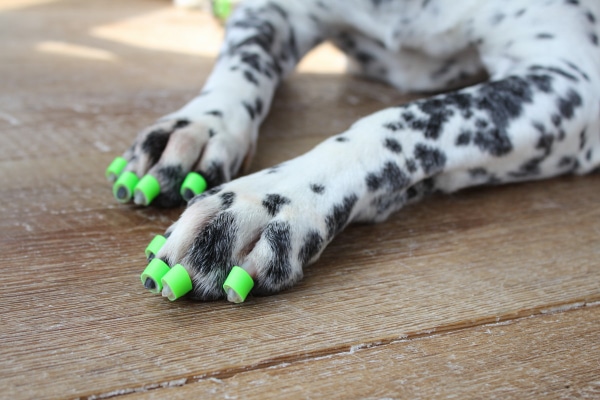
#2: Weight management
Weight management is essential to the success of conservative treatment for a torn cruciate ligament. Since dogs with a CCL injury are on restricted activity, you should consult with your veterinarian about how to modify your dog’s diet to avoid weight gain.
Also, if your dog is overweight, it is imperative that he or she loses weight and maintains a lean body weight. Less weight will result in less force on the joint, which will improve function and comfort. Diet is a crucial part of helping your dog lose weight. It can be useful to ask your veterinarian to calculate your dog’s ideal caloric intake for weight loss and maintenance. And the vet can also help determine when your dog is ready to resume low-impact activity, which will also help with maintaining a healthy weight.
#3: Medications to reduce pain and inflammation
Your veterinarian will prescribe various medications to help reduce inflammation and improve comfort initially, as well as long-term. Often, he or she will also recommend using other conservative management strategies at the same time. This can help reduce the dose or frequency of medication needed to keep your dog comfortable.
Based on your dog’s overall health, injury, and pain level, your vet will decide which medication or medications are going to be best for your dog. And he or she will discuss the benefits and possible adverse effects of each medication with you too.
Some possible medications include:
- Non-steroidal anti-inflammatory drugs (NSAIDs) such as Rimadyl® (carprofen for dogs), Galliprant® (grapiprant), Metacam® (meloxicam), Previcox® (firocoxib), and Deramaxx® (deracoxib)
- Gabapentin for dogs
If you notice any side effects from the medications, please notify your veterinarian promptly. Also, keep in mind that if your dog is on daily medications, your vet may recommend blood work every 6 to 12 months to ensure your dog is tolerating the medication well.
#4: Nutraceuticals
Nutraceuticals (e.g. joint supplements for dogs) are often used to help reduce joint inflammation and slow the progression of osteoarthritis in dogs. There are multiple commercially-available joint supplements for dogs, which can make it difficult for dog owners to choose one. However, your veterinarian can help you figure out which joint supplement will be best for your dog.
The ideal joint supplement should have demonstrated efficacy and bioavailability, and ideally have in vivo testing (i.e. testing in animals) with a randomized clinical trial. There should also be quality assurance with a third-party laboratory.
Components that have been shown to reduce inflammation associated with osteoarthritis include:
- Glucosamine/chondroitin sulfate joint supplements
- Omega-3 fatty acids for dogs supplements
- Methylsulfonylmethane (MSM)
- Curcumin longa extract
- Boswellia serrata extract
- Green lipped mussel for dogs
- Egg shell membrane
There are multiple options available, including Dr. Buzby’s Encore Mobility™ hip and joint supplement, Dasuquin® Advanced + ESM, Phycox® Max, Movoflex®, Glycoflex®, YuMOVE®, Flexadin® Advanced, Antinol®, and Welactin® Advanced. Your veterinarian will recommend the best option for your dog’s situation.
#5: Rehabilitation therapy
Rehabilitation therapy is often recommended to help reduce inflammation and swelling and improve range of motion, comfort, and function. This typically involves working with a provider certified in rehabilitation therapy for dogs and cats. The rehabilitation therapist often performs therapies in-clinic in addition to recommending an at-home exercise program that you can do with your dog.
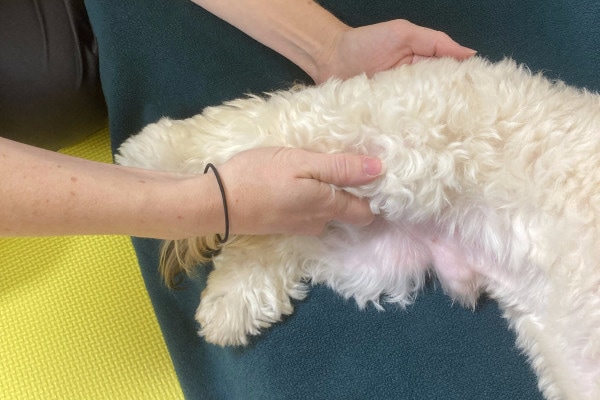
Therapies that can help manage CCL injury are:
- Manual/massage therapy
- Low level laser therapy for dogs
- Extracorporeal shockwave therapy
- Therapeutic ultrasound
- Transcutaneous electrical nerve stimulation (TENS)
- Pulsed electromagnetic field therapy (PEMF for dogs)
- Therapeutic exercise
- Hydrotherapy (underwater treadmill for dogs or swimming)
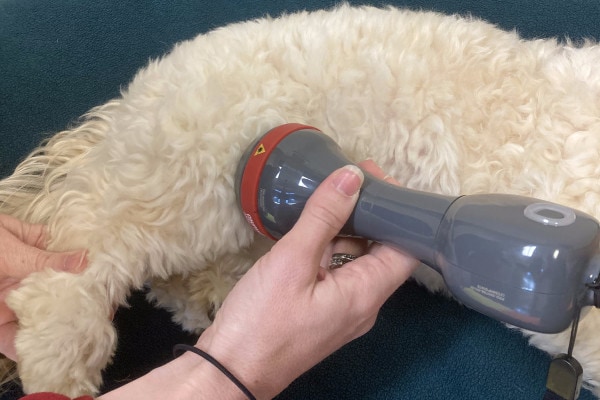
The rehabilitation therapist will decide which therapies will be best for your dog. Dogs often receive rehabilitation therapy weekly for the first 12 weeks. Then the therapist may recommend spacing out the scheduled appointments for the maintenance phase.
#6: Intra-articular therapies
The veterinarian or rehabilitation therapist may recommend intra-articular therapies (i.e. joint injections) to help reduce inflammation within the joint and improve overall comfort. There are multiple options available for dogs, including:
- Hyaluronic acid (HA)
- Platelet rich plasma (PRP for dogs)
- Stem cell/PRP therapy
- Cortisone (steroid)
Your veterinarian will determine if your dog is a candidate for intra-articular therapies, and if so, which type of joint injection will be best.
#7: Stifle orthotic (knee brace)
While there are multiple commercially-available dog ACL braces, few have been scientifically proven to help. The braces that have been scientifically validated are custom, hinged stifle orthotics—ones that an orthotist made specifically for the dog.
To make a custom, hinged stifle orthotic, a veterinarian or rehabilitation therapist will make casting of the affected limb. Then he or she will send the casting to the orthotist, who makes a mold of the limb from the cast. After making the mold of the limb, the orthotist builds a knee brace specifically for the limb.
Then he or she sends the knee brace back to the veterinarian or rehabilitation therapist for fitting. Once your dog is fit for the brace, he or she will wear the brace intermittently over the next couple of weeks while he or she becomes accustomed to it. But ultimately your dog should wear the stifle brace any time he or she is active. And then you can remove it when your dog is at rest.
Common complications of a knee brace include rub sores, slipping, and improper fit. Also, it is important to know that dogs with knee braces may benefit from rehabilitation therapy to help them maintain muscle mass.
Your veterinarian or rehabilitation therapist will determine if your dog is a good candidate for a knee brace.
Tumbles’ success story
Tumbles’ veterinarian recommended activity modifications, prescribed a non-steroidal anti-inflammatory drug, calculated a calorie count to help him maintain a healthy weight, and referred him to me for rehabilitation therapy. I started him on weekly manual/massage therapy, low level laser therapy for his knee, therapeutic exercise, and a home exercise program.
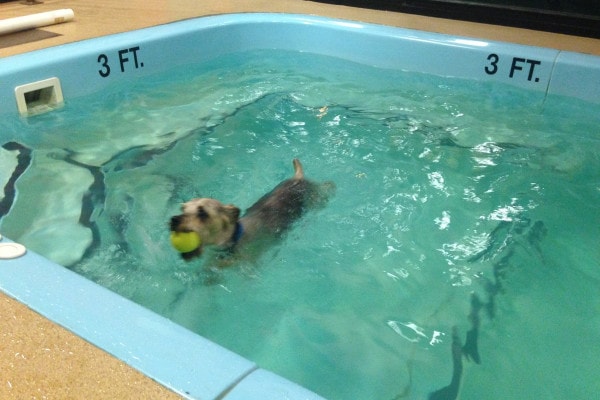
Four weeks into rehabilitation therapy, I added underwater treadmill therapy to his therapy program. At this point, he was comfortable enough that he was just taking the NSAID as needed.
Then at 12 weeks, Tumbles’ veterinarian and I cleared him to resume low-impact activity. And he moved to once-monthly rehabilitation therapy appointments. We discussed avoiding squirrel chasing and chasing the ball. However, we did encourage Tumbles to swim and take short walks as long as he remained comfortable
At 16 weeks, Tumbles transitioned from underwater treadmill therapy to swimming for short periods of time under my vigilant supervision. His owners had a pool, and they were able to carefully restart short periods of swimming at home three times per week. On the days he wasn’t swimming, Tumbles would participate in short leash walks within his comfort.
At 6 months following his injury, Tumble’s owners reported they were very pleased with his outcome and level of comfort and function at home!
Note from Dr. Buzby
I hope this article from Dr. Carr Benson gave you hope and equipped you with the information you need to advocate for your dog. While l still firmly believe that surgery is the gold standard treatment for ACL tears, the interventions Dr. Carr Benson discussed can make a huge difference for your dog’s comfort and recovery in cases where surgery isn’t an option.
About the author

Dr. Britt Carr Benson is a diplomate of the American College of Veterinary Sports Medicine and Rehabilitation. She earned her Bachelor of Science in biology from Furman University in Greenville, South Carolina. She then attended the Virginia-Maryland College of Veterinary Medicine at Virginia Tech in Blacksburg, Virginia.
After earning her Doctor of Veterinary Medicine, Dr. Carr Benson completed a small animal rotating internship at the Animal Specialty Group in Los Angeles, California followed by a small animal surgery and sports medicine internship at Veterinary Orthopedic and Sports Medicine Group (VOSM) in Maryland. She then remained at VOSM to complete a residency in canine sports medicine and rehabilitation. During her residency, Dr. Carr Benson attended the Canine Rehabilitation Institute and is also a Certified Canine Rehabilitation Therapist.
She has co-authored dozens of peer-reviewed publications and several textbook chapters. She is a national speaker and instructor as well as a recipient of many awards and honors for her work.
If you decided to treat your dog’s torn ACL without surgery, how did he or she do?
Please share your experiences below.


My 3 year old large border collie mix has a cal injury. She is on pain meds, and drugs to keep her quiet. She has always been very active running etc. the vet is doing laser therapy but has not brought up surgery. Why? I am a senior but would do anything to let Lady have her normal life back. Should I bring up option of surgery
Hi Paula,
I am sorry your young dog is having issues with her knee. If you are interested in surgery or just want more information, I would definitely bring this up in your next conversation with your vet. There may be reasons why they have not mentioned surgery as an option. They may be wanting to see if medical management can resolve the issue. Also, some dogs are not good anesthesia candidates. You can always ask for a consultation with an orthopedic specialist if needed. Wishing you and Lady all the best.
Hi, our 11 year old lab tore her second ccl. She seems to be comfortable when resting but uncomfortable when we take her on small potty trips despite anti-inflammatories. Surgery is not a financial option. Will her chances of recovery be in her future? She has been the best dog ever and we don’t want to see her suffer. Do the Velcro’ leg braces help with pain as it reduces movement?
Hi Jennifer,
I am sorry your senior girl is experiencing pain from a CCL tear. There are dogs that don’t have this injury surgically corrected and do go on to make a full recovery. Most of the time this requires some degree of physical therapy as the article mentions. A brace may be a good option for your pup, but they aren’t the right solution for every dog. The main goal of treating a CCL tear is to reduce inflammation and pain. I will attach links to other articles with more information. Hoping you can find what works best for everyone involved.
1. Natural Pain Relief for Dogs: 17 Methods from a Vet
2. Dog ACL Brace? Veterinarians Share Answers
3. Torn ACL in Dogs: Signs, Symptoms, Surgery Options
4. Amantadine for Dogs: Everything You Need To Know
5. What is Gabapentin for Dogs?
We have a 4yr old Brittany who has torn both acl “s on both hind legs. The left is far more worse than the right. Surgery is recommended, 4k each leg with long recovery periods b/w surgeries. We have ordered a dual hinged brace to help him why we try and find another vet with much more reasonable cost. In the meantime, he is on pain medication, and joint treats.
He is overweight, and with his decline in movement, is unable to lose weight. He only receives 1/2 cup of food x2 per day. Should we be crating him to keep his mobility down? We have to lift him onto the bed, car, etc. But he jumps down, should we be restricting this also?
He is a great companion and bird hunter. We are heartbroken for him.
Thanks for any advice to help our pup.
Hi Dee,
I am sorry you are in this difficult situation with your young dog. It is hard to know what is best without playing a personal role in his medical care. While you don’t want your boy using his bad legs too much, you also don’t want to completely restrict activity as this will affect his other joints. The saying “if you don’t use it, you lose it” is very true. His hips and other joints still need activity and to go through their range of motion. I highly recommend you consider getting him involved with a veterinary rehabilitation professional. They can offer therapies and exercise in many different forms (underwater treadmill, balancing, hemi standing and walking, laser therapy, etc.) that will not only help your boy lose weight but can also decrease inflammation and pain. Jumping is not a good idea with these damaged joints, but at least when jumping down most of the force is absorbed by the front legs and not the rear. Hoping you get your pup the help he needs and restore his quality of life. Wishing you all the best of luck and keep us updated on the progress!
Hi. Our 9 year old Lucy just tore her acl and we cannot afford the surgery which is devastating. Is it worth it to try one of the braces to see if it can help? We have the rimadyl and have been resting her. We don’t want her quality of life to be affected or even worse have something awful happen due to her situation. Are there acute injuries that can happen when you leave the torn acl? Like an injury that could cause her to be in a horribly worse situation? We are just beyond heart broken.
Thank you in advance.
Hi Jennifer,
I am sorry Lucy has injured her knee and you are stuck in this difficult situation. I understand how hard it can be when finances limit the options despite wanting to do what is best for your girl. A brace may be a good idea, but I strongly recommend you have a rehabilitation veterinarian assess Lucy to see if she is a good candidate. If they think it would help, they can also take the necessary measurements to ensure you get a custom fit. If the torn ligament is left untreated and inflammation and pain are not well controlled, there is a risk of tearing the meniscus (cartilage cushion) in the knee resulting in more pain and trauma and leaving bone rubbing on bone. This will also predispose Lucy to arthritis formation. With that being said, it is possible to get good results without surgery in some cases. Hoping you can find the best solution for you and Lucy. Wishing your sweet girl many happy years ahead.
I have a very active 7 year old Border Collie/Greyhound whose right rear leg CCL tore one year ago. I did not choose surgery for her because of the minimum of $5,000 and many weeks of confinement (not possible for my active dog!) She quickly adapted to walking on three legs, then to walking on 3 and running on 3, then to walking slowly on 4, etc. After about 4 months she showed no sign of discomfort, injury, or limping. We just passed the one year mark and I don’t think anyone could tell that her CCL was torn.
I gave her pain pills the first two days of the injury and no further medication. Since the CCL tore, I have given her Cosequin and 500 mg of Omega 3 every day, reduced her calorie intake, given her lots of protein (meat, chicken, milk, etc.). I do not allow her to jump into my car; I lift her 50 lbs and until just recently I lifted her onto our couch but now allow her to jump. I do not allow her to rough house with other dogs because that would put a strain on her rear lets.
Dog Pepper, my wife, and I are very happy that we did not choose surgery.
Hi Al,
What a great outcome! I am so glad Pepper is able to continue living her best life and is showing no lingering issues from her CCL tear. Thank you for sharing your experience with us. Wishing you and your family many happy days ahead. ♥
My 10 yo Old English Bulldog has torn her ACL.She does not express any pain.She won’t fully bear weight on the leg but gets around fairly well.She still wants to play ball,etc….
She has no major health issues,but is 10.
I am a PT.What do you recommend exercise wise that I might do for my beautiful little lady??
Do you think surgery at 10 is still possible?
Thank you!!
William
Hi William,
I am sorry your senior girl has injured her knee. Surgery is definitely still possible at her age as long as her lab work doesn’t show any issues that would make her an increased risk for anesthesia. It is hard to make specific recommendations for exercises without having personally examined your pup. The treatment recommended depends on the degree of inflammation present in the joint. I know you said she is not expressing any pain, but the unwillingness to bear full weight on the limb is an expression of pain. Laser therapy can be very helpful for this type of injury. I will attach links to other articles with more information. Hoping you can find a way to ensure your girl continues to live her best life. Best wishes and take care!
Which laser is best for us to use at home? I’ve been seeing mixed reviews on many of them & hesitate to waste the money. My 3 year old Rottie definitely did something but even after X-rays the vet was very vague about options other than a 5k surgery, looking for a new vet but still would love an informed opinion. Thanks for all the information
Hi Shauna,
I think it is great you are looking into laser therapy for your pup. Unfortunately, I don’t have any specific advice as far as at home laser units are concerned. I can tell you that the main difference between units is the time it takes to deliver the prescribed dose of light energy. A lesser powered unit may be able to administer the same treatment as a stronger unit it just takes more time to do so. Of course, there are other variables, but time is the main one. Hoping you can find a way to offer your pup relief. Wishing you all the best as you navigate this unknown path.
My 15-1/2 y/o Maltese-mix girl just tore her left ccl. She tore her right one 4 years ago, had surgery, and a great recovery. She has been very active with our 5 y/o Maltese ever since. However, now with her advanced age, and a low grade murmur, I am hesitant to put her through another surgery. Looking to do all the non-surgery therapies, but wonder how her current non use of her left leg is putting strain/stress on the previously injured right leg? Her weight is appropriate. Would a custom brace allow her to weight bear sooner? Definitely want to avoid any excessive muscle atrophy. Friends have a pool, although she doesn’t like swimming-lol.
Thank you so much for your input.
Hi Cathy,
I understand your concern for your senior girl and think it is great you are searching for advice. She is lucky to have you advocating for her health and well-being. Generally, I am not a fan of braces, but they do have their place. Your girl may be a good candidate for a brace, and I recommend you ask your vet or a veterinary rehabilitation professional for their input. Here is a link to another article with more information: Dog ACL Brace? Veterinarians Share Answers
Hoping you can find the answers you need to navigate this difficult path. Praying for healing and relief for your pup and wishing you both all the best.
My 8 year old Havanese has been diagnosed with a CCL injury. He has been limping on/off for about 2 months. He is taking Metacam and some joint supplements but has shown minimal improvement. He is overweight at 25 pounds and has a heart murmur. The orthopaedic vet recommends TPLO surgery, but that scares me. I am worried about complications and the long recovery period for surgery, but non-surgical options seem just as long or longer. I have another 5 year old Havanese who is very active and I’m not sure how I can separate them for so long. I feel the vets are pushing for surgery and so far have only suggested restricting activity as the alternative. I’m looking for long term success stories of non-surgical treatment in similar circumstances.
Hi Kathryn,
I am sorry you are dealing with this difficult situation with your boy. Without examining him myself, it is hard to make specific conclusions and recommendations. There are many different surgical techniques that can be used to stabilize the knee joint and many success stories from readers who have opted to forgo surgery and pursue medical management. My best advice is to read through the comments section of all the different articles that pertain to a torn cruciate ligament. I will attach the links below. Also, you may find some new information or ideas of treatments to discuss with your vet in these other articles. Hoping you can get the answers you need to find a clear path forward. Wishing you and your sweet boy all the best of luck!
1. Dog ACL Brace? Veterinarians Share Answers
2. Torn ACL in Dogs: Signs, Symptoms, Surgery Options
3. TPLO Surgery for Dogs with a Torn Cruciate Ligament
4. A Veterinarian Answers Your TPLO Recovery FAQs
5. Cruciate Ligament Rupture in Dogs: The Partial Tear
6. Natural Pain Relief for Dogs: 13 Methods
My 10yr old 70 pound baby tore is ccl. With health/finical issues being a problem he is not able to have surgery. I was wondering how soon after the injury does therapy/exercises need to start? The arrival was very helpful. Thanks you!
Hi Elizabeth,
I am sorry your big guy has injured his knee. Rehabilitation is wonderful and could help restore your boy’s quality of life. I would recommend starting therapy right away. Even in the early stages when physical exercise is not possible, there are treatments and therapies that your rehab vet can use to help reduce swelling, pain, and inflammation. Once these are better under control, the exercises can begin. Your rehab vet will tailor the exercise protocol to your dog’s specific needs making sure to take into consideration his stage of healing and level of fitness. Wishing you all the best and praying for a full recovery.
Thank you for sharing this information. I have a 5 year old lab that is overweight. She has a torn cruciate ligament, thought to be a partial. I can’t afford the surgery and I’m hoping she will be ok without it. I’ve ordered a brace from goherogo and it seems to help take her out of pain. She is also receiving laser therapy and underwater treadmill along with natural anti inflammatory. I’m hoping that she will have a mostly pain free life at some point. I keep looking for success stories. I don’t want her to suffer.
Hi Kari,
I am sorry your Lab has injured her knee. It sounds like you are doing a lot of great things to help reduce inflammation and ensure she stays mobile. Here is another article you may want to look through which also has some comments from other readers (you may find more success stories!): Cruciate Ligament Rupture in Dogs: The Partial Tear
Praying your girl can continue to heal and make a full recovery. Keep up the good work!
Our GSP was 13 when she tore her CCL. She too had a heart condition and also had occasional seizures. We met w a surgeon who felt the risk was too high for us to do surgery. We ended up going w a custom fit knee brace from Posh Dog Knee Brace company. The investment was $700 at the times. They work to fit the dog after your take the measurements and the brace arrived in a week after we ordered. This brace was game changing for my dogs quality of life. The minute we put it on and got her fitted properly, she barked with happiness. Slowly but surely she was able to get back to walking with out the brace.
We also also used Carprofen, natural supplements, Chinese herbs, hired a rehab vet and did acupuncture. Doing all of these combined modalities was even more cost effective than the surgery. Not only that, we didn’t have to confined her to a crate for 6 weeks as a tplo surgery would have required. I highly recommend this path vs surgery. Posh dog knee brace actually recommends Dr Buzby’s toe grips and that’s how I learned of your company. 😊
Hi Tami,
I am glad your senior girl did so well with her knee brace! Thank you for sharing your story with our readers. Best wishes to you and yours!
Hi
I would like to connect with you to underStand your success with your baby , my baby is 10years old is a yorkie and weights 5kg . Please let me know how can I connect with you . Thank you.